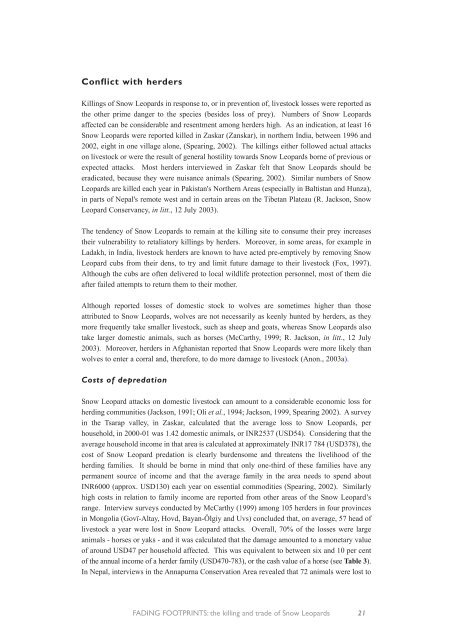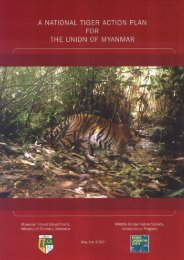Download - Global Tiger Initiative
Download - Global Tiger Initiative
Download - Global Tiger Initiative
Create successful ePaper yourself
Turn your PDF publications into a flip-book with our unique Google optimized e-Paper software.
Conflict with herders<br />
Killings of Snow Leopards in response to, or in prevention of, livestock losses were reported as<br />
the other prime danger to the species (besides loss of prey). Numbers of Snow Leopards<br />
affected can be considerable and resentment among herders high. As an indication, at least 16<br />
Snow Leopards were reported killed in Zaskar (Zanskar), in northern India, between 1996 and<br />
2002, eight in one village alone, (Spearing, 2002). The killings either followed actual attacks<br />
on livestock or were the result of general hostility towards Snow Leopards borne of previous or<br />
expected attacks. Most herders interviewed in Zaskar felt that Snow Leopards should be<br />
eradicated, because they were nuisance animals (Spearing, 2002). Similar numbers of Snow<br />
Leopards are killed each year in Pakistan's Northern Areas (especially in Baltistan and Hunza),<br />
in parts of Nepal's remote west and in certain areas on the Tibetan Plateau (R. Jackson, Snow<br />
Leopard Conservancy, in litt., 12 July 2003).<br />
The tendency of Snow Leopards to remain at the killing site to consume their prey increases<br />
their vulnerability to retaliatory killings by herders. Moreover, in some areas, for example in<br />
Ladakh, in India, livestock herders are known to have acted pre-emptively by removing Snow<br />
Leopard cubs from their dens, to try and limit future damage to their livestock (Fox, 1997).<br />
Although the cubs are often delivered to local wildlife protection personnel, most of them die<br />
after failed attempts to return them to their mother.<br />
Although reported losses of domestic stock to wolves are sometimes higher than those<br />
attributed to Snow Leopards, wolves are not necessarily as keenly hunted by herders, as they<br />
more frequently take smaller livestock, such as sheep and goats, whereas Snow Leopards also<br />
take larger domestic animals, such as horses (McCarthy, 1999; R. Jackson, in litt., 12 July<br />
2003). Moreover, herders in Afghanistan reported that Snow Leopards were more likely than<br />
wolves to enter a corral and, therefore, to do more damage to livestock (Anon., 2003a).<br />
Costs of depredation<br />
Snow Leopard attacks on domestic livestock can amount to a considerable economic loss for<br />
herding communities (Jackson, 1991; Oli et al., 1994; Jackson, 1999, Spearing 2002). A survey<br />
in the Tsarap valley, in Zaskar, calculated that the average loss to Snow Leopards, per<br />
household, in 2000-01 was 1.42 domestic animals, or INR2537 (USD54). Considering that the<br />
average household income in that area is calculated at approximately INR17 784 (USD378), the<br />
cost of Snow Leopard predation is clearly burdensome and threatens the livelihood of the<br />
herding families. It should be borne in mind that only one-third of these families have any<br />
permanent source of income and that the average family in the area needs to spend about<br />
INR6000 (approx. USD130) each year on essential commodities (Spearing, 2002). Similarly<br />
high costs in relation to family income are reported from other areas of the Snow Leopard’s<br />
range. Interview surveys conducted by McCarthy (1999) among 105 herders in four provinces<br />
in Mongolia (Govï-Altay, Hovd, Bayan-Ölgiy and Uvs) concluded that, on average, 57 head of<br />
livestock a year were lost in Snow Leopard attacks. Overall, 70% of the losses were large<br />
animals - horses or yaks - and it was calculated that the damage amounted to a monetary value<br />
of around USD47 per household affected. This was equivalent to between six and 10 per cent<br />
of the annual income of a herder family (USD470-783), or the cash value of a horse (see Table 3).<br />
In Nepal, interviews in the Annapurna Conservation Area revealed that 72 animals were lost to<br />
FADING FOOTPRINTS: the killing and trade of Snow Leopards 21

















